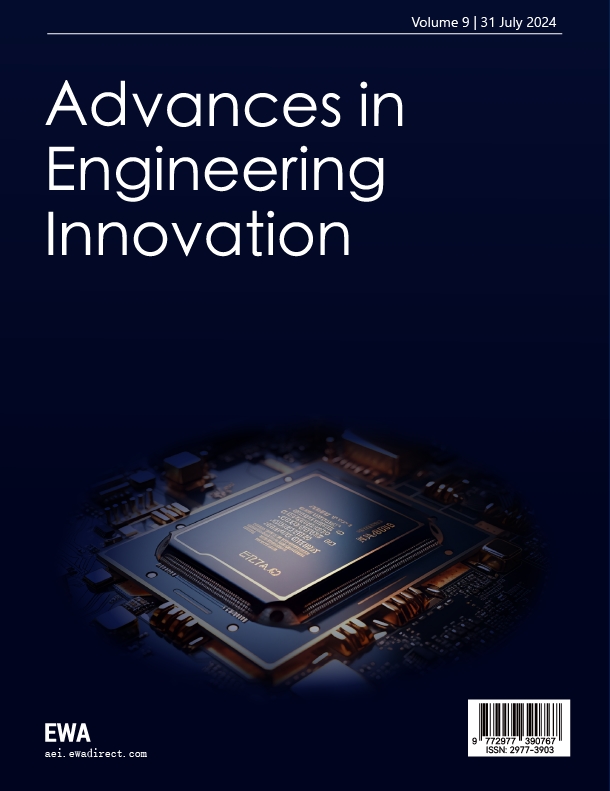1. Introduction
With the rapid development and expanding application domains of radar technology, the demand for Radar Absorbing Materials (RAMs) has progressively increased, particularly in fields such as stealth technology, electronic countermeasures, and intelligent transportation. The fundamental function of RAMs is to reduce the reflection of radar waves and enhance the absorption of electromagnetic waves. However, traditional absorbing materials have primarily focused on the suppression of electromagnetic wave reflectivity, while their performance in attenuating surface waves has often been neglected. When electromagnetic waves are incident upon a conductor, surface currents (or creeping waves/surface waves) are excited and induced on the conductor's surface. These surface currents propagate along the conductor surface; when encountering electromagnetic discontinuities on the surface, they become sources of electromagnetic radiation. The existence of such surface waves was first predicted by Ritchie at Oak Ridge National Laboratory in the USA in 1957 [1]. Subsequent in-depth research revealed numerous novel properties of surface waves, attracting increasing attention from researchers, among whom Raether [2], Otto [3, 4], and Kretschmann are particularly notable [5].
Due to the long-range detection characteristics of radar, targets possess not only vertical reflecting surfaces but also large areas subject to grazing incidence electromagnetic waves. Significant grazing incidence results in strong surface currents forming on the target surface. Because of the inherent structural features of targets, numerous electromagnetic discontinuities inevitably form, which act as numerous radiation sources. The presence of these numerous radiation sources can significantly degrade the stealth effectiveness of a target. Consequently, the existence of surface wave scattering can substantially diminish the practical performance of RAMs. Therefore, enhancing the surface wave attenuation performance of absorbing materials has become a crucial direction in current research.
Surface wave attenuation performance is not only closely related to the electromagnetic properties of the material but also intrinsically linked to its surface morphology, structural design, and response characteristics across multiple frequency bands. Therefore, investigating the surface wave attenuation characteristics of different types of absorbing materials can provide theoretical support and practical basis for the design of highly efficient radar stealth materials. This paper reviews the relevant literature to explore the research progress on the surface wave attenuation performance of radar absorbing materials and outlines potential future research directions.
2. Introduction to radar surface waves
2.1. Basic types of surface waves
Surface waves studied to date can be broadly categorized into three types [6]: Surface Plasmon Polariton (SPP) waves, Dyakonov waves, and Tamm waves. Surface Plasmon Polariton (SPP) waves are surface electromagnetic waves excited at the interface between a metal plate and a dielectric material, which may be either isotropic or anisotropic. SPP waves represent the most extensively researched type of surface wave. A schematic model of SPP waves is provided in Figure 1.
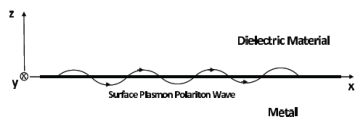
2.2. Propagation characteristics of surface waves
The propagation characteristics of surface waves are typically determined by their dispersion relations. In certain material systems, surface waves can propagate with relatively low losses and exhibit strong stability within specific frequency ranges. The propagation path of surface waves is influenced by multiple factors, such as the electromagnetic parameters of the absorbing material on the metal surface and the external environmental electromagnetic field [7]. Generally, the attenuation constant β can be equivalently expressed as the sum of dielectric loss αₑ and magnetic loss αₘ. Here,
where Pₑ and Pₘ represent the total dielectric loss energy and total magnetic loss energy per unit length along the z-axis, respectively, and
3. Research progress on surface wave attenuation of various absorbing materials
3.1. Magnetic loss absorbing materials
Magnetic absorbing materials, such as ferrites and magnetic composites, are widely utilized in Radar Absorbing Material (RAM) research. In recent years, surface wave testing techniques have matured significantly [8, 9]. Extensive experiments have demonstrated that magnetic RAMs exhibit strong surface wave attenuation performance, primarily attributed to their magnetic anisotropy and magnetic loss. These materials influence radar wave propagation through variations in permeability, effectively suppressing surface wave propagation.
Huang discovered that for high-frequency surface waves [10], RAM coatings can achieve strong attenuation absorption with minimal thickness, whereas low-frequency surface waves require thicker coatings. Combining Frequency-Selective Surfaces (FSS) with RAM coatings enables strong low-frequency surface wave attenuation even with thin coatings.
This finding suggests that alternating designs of pure RAM coatings and FSS-RAM composite coatings may achieve high surface wave attenuation across broad radar bands with minimal weight, facilitating balanced high-performance radar stealth for entire targets.
Wang et al. developed NiCuZn ferrite-based composites for the P-band [11], investigating their impact on P-band surface wave suppression. Using Stratton’s surface wave attenuation calculation method, they analyzed the relationship between attenuation rate and coating thickness, identifying the attenuation bands for composites with varying ferrite absorber content. Results showed that increasing ferrite mass fraction enhanced electromagnetic parameters; at a 5:1 ferrite-to-paraffin ratio, a 10-mm composite exhibited optimal surface wave attenuation (>20 dB/m within 570–998 MHz).
Rao fabricated magnetic loss flexible RAMs via tape casting, demonstrating excellent absorption and electromagnetic properties [12]. Analysis of dispersion equations, electromagnetic field distributions, and attenuation tests confirmed effective surface wave suppression across 1–18 GHz, with attenuation intensifying at higher frequencies (see Figure 2). While limited in low frequencies, significant attenuation was achieved at 18 GHz (34.15 dB/m).
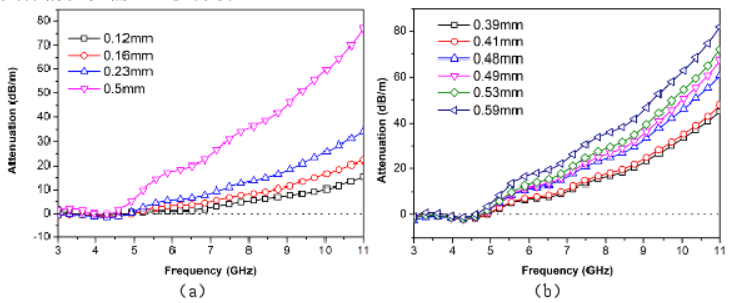
Zheng conducted theoretical calculations, simulations, and experiments on FeCo@SiO₂ coatings with both electric and magnetic loss [13]. Surface wave scattering peak angles were predicted via propagation models, coating thickness effects on attenuation coefficients were discussed, and contributions of electric/magnetic losses to attenuation were quantified. Results revealed that attenuation coefficients first increased then decreased with thicker coatings, dominated by magnetic loss.
Zhang et al. applied a 1-mm artificial magnetic RAM (
3.2. Electric loss absorbing materials
Magnetic RAMs suffer from high weight, poor corrosion resistance, and mechanical fragility. Electric loss RAMs overcome these limitations but face challenges in achieving broadband performance under thickness constraints.
Li defined TM-mode surface wave attenuation impedance matching for single/multilayer RAMs, linking it to reflectivity impedance matching [15]. Analysis yielded electromagnetic parameter requirements for simultaneous reflectivity suppression and TM-mode surface wave attenuation. For multilayer electric loss RAMs, structural design should follow a gradient: electromagnetic parameters increase from top to bottom layers.
Liu et al. simulated graphene foam RAMs, varying thickness (10–30 mm),
Chopped carbon fibers—a resistive loss absorber—leverage resonance, eddy currents, and phase cancellation. Their anisotropic morphology yields unique electromagnetic interactions. Similar absorbers include activated, porous, and nanoscale carbon fibers, carbon nanotubes, SiC fibers, and modified fibers [17–20]. Research focuses on enhancing attenuation intensity, bandwidth, and thinness while ensuring lightweight, broadband, and corrosion-resistant performance. For instance: Xing et al [21].: 8.5-mm graded-impedance composite achieved <-10 dB reflectivity (3–18 GHz). Zhao et al [22].: 4-mm laminate (three 0.2–0.4 mm graded layers) achieved <-10 dB reflectivity (5–18 GHz). Liu et al [23].: 5.2-mm Jaumann absorber with multi-walled carbon nanotubes achieved 11.6 GHz -10 dB bandwidth.
Most studies optimize reflectivity via material selection and layer thickness but neglect surface wave attenuation. In practice, oblique microwave incidence excites surface waves on conductors, where attenuation capability critically impacts Radar Cross-Section (RCS). Investigating surface wave attenuation mechanisms is thus vital for designing advanced RAMs.
3.3. Metamaterials
Recent advances in metamaterials have spurred research into surface wave attenuation. Current strategies exploit finely tuned array structures to manipulate surface waves. To simplify designs, attention has shifted to nonlinear surface waves, where external physical fields (e.g., intensity) modulate wave properties [24]. Figure 3 illustrates two typical nonlinear surface wave models.

Zhu et al. designed a serpentine-patterned structure, improving surface wave attenuation [25]. Optimized electromagnetic parameters and patterning raised the upper cutoff frequency from 4 GHz to 8 GHz (see Figure 4), enabling broadband high-attenuation RAM designs.
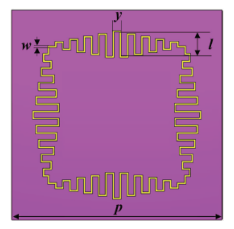
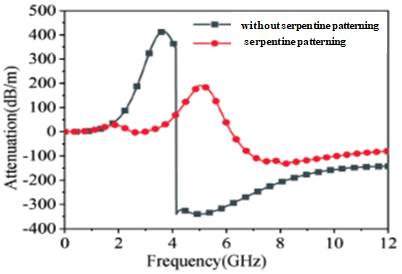
Zheng designed a magnetic metamaterial RAM using resistive ink-printed FSS, magnetic top layers, and dielectric substrates [13]. Simulations confirmed reduced RCS across incident angles via suppressed surface waves and specular reflection, achieving >90% absorption in S/C bands (2–8 GHz, 120% bandwidth) at 5-mm thickness—outperforming existing literature.
Zhang designed periodic-structure-enhanced RAMs, analyzing reflectivity and surface wave attenuation [26]. Improved low-frequency attenuation (1 GHz: 3.64 dB/m → 12.84 dB/m, see Table 1) was achieved by increasing thickness, optimizing electromagnetic parameters, multilayer stacking, and patterning resistive/metal films.
|
Structure |
RAM |
resistive films |
Square resistive films |
Square metal films |
|
Attenuation(dB/m) |
3.64 |
5.01 |
11.3 |
12.84 |
4. Conclusions and perspectives
Research on surface wave attenuation in RAMs has gained momentum. Magnetic, electric loss, and metamaterial-based RAMs exhibit varying degrees of surface wave attenuation. However, limitations persist, such as poor low-frequency attenuation and narrow bandwidths. Future work should prioritize: (1) Multifunctional composites: Optimize conductive-magnetic hybrids for enhanced multi-type wave absorption. (2) Nanomaterials and microstructural design: Leverage nanotech and microengineering to boost broadband (especially low-frequency) attenuation. (3) Metamaterials and tunability: Develop smart RAMs with dynamically adjustable attenuation via metamaterials and external stimuli. Despite progress, theoretical and practical challenges remain. Advancements in materials science, metamaterial design, and intelligent control will drive next-generation high-performance RAMs.
References
[1]. Ritchie, R. H. (1957). Plasma losses by fast electrons in thin films.Physical Review, 106(5), 874–881. https: //doi.org/10.1103/PhysRev.106.874
[2]. Raether, H. (1988). Surface plasmons on gratings. InSurface plasmons on smooth and rough surfaces and on gratings(pp. 91–116). Springer. https: //doi.org/10.1007/978-3-642-97157-4_4
[3]. Otto, A. (1968). Excitation of nonradiative surface plasma waves in silver by the method of frustrated total reflection.Zeitschrift für Physik, 216(4), 398–410. https: //doi.org/10.1007/BF01391532
[4]. Otto, A. (1969). Excitation by light of ω⁺ and ω⁻ surface plasma waves in thin metal layers.Zeitschrift für Physik, 219(3), 227–233. https: //doi.org/10.1007/BF01894337
[5]. Kretschmann, E. (1972). The angular dependence and the polarisation of light emitted by surface plasmons on metals due to roughness.Optics Communications, 5(5), 331–336. https: //doi.org/10.1016/0030-4018(72)90012-2
[6]. Polo, J. A., & Lakhtakia, A. (2011). Surface electromagnetic waves: A review.Laser & Photonics Reviews, 5(2), 234–246. https: //doi.org/10.1002/lpor.201000014
[7]. Li, Y., Li, D., Wang, X., Chen, S., & Zhang, L. (2018). Influence of the electromagnetic parameters on the surface wave attenuation in thin absorbing layers.AIP Advances, 8(5), 056616. https: //doi.org/10.1063/1.5005795
[8]. Huang, Z. (2017). Research on test technology and system for material surface wave suppression [Unpublished doctoral dissertation, University of Electronic Science and Technology of China].
[9]. Zhao, X. (2022). Research on portable detection technology for surface wave attenuation rate of absorbing materials [Unpublished master's thesis, University of Electronic Science and Technology of China].
[10]. Huang, D., Ha, E., He, S., & Li, J. (2005). Study on the attenuation characteristics of broadband radar surface waves.Journal of Materials Engineering, (3), 4.
[11]. Wang, H., Wang, D., Luo, Q., & Sun, Y. (2019). Study on surface wave absorbing properties of NiCuZn ferrite matrix composites.Electronic Components and Materials, 38(8), 55–60. https: //doi.org/10.14106/j.cnki.1001-2028.2019.08.002
[12]. Rao, H. (2020). Study on the influence of electromagnetic defects in flexible materials on surface wave transmission characteristics [Unpublished master's thesis, University of Electronic Science and Technology of China].
[13]. Zheng, L. (2022). Study on the propagation and attenuation mechanism of surface waves in radar absorbing materials [Unpublished master's thesis, Wuhan University of Science and Technology].
[14]. Zhang, W., Ai, J., & Wang, J. (2021). Analysis of electromagnetic scattering characteristics of wing trailing edge.Telecommunication Engineering, 61(2), 242–247. https: //doi.org/10.3969/j.issn.1001-893x.2021.02.014
[15]. Li, Y. (2021). Study on surface wave attenuation characteristics of thin-layer absorbing materials [Unpublished master's thesis, Huazhong University of Science and Technology].
[16]. Liu, W., Xiong, J., He, S., & Zhang, R. (2022). Study on surface wave attenuation characteristics of graphene foam absorbing materials.Journal of Ordnance Equipment Engineering, 43(3), 293–299.
[17]. Zhou, Z., Zhao, Y., Wang, Z., Liu, X., & Chen, Q. (2023). The design and fabrication of a broadband metamaterial absorber based on a double-layer ring structure.Journal of Magnetism and Magnetic Materials, 586, 171203. https: //doi.org/10.1016/j.jmmm.2023.171203
[18]. Park, K.-Y., Lee, S.-E., & Kim, C.-G. (2006). Fabrication and electromagnetic characteristics of electromagnetic wave absorbing sandwich structures.Composites Science and Technology, 66(3–4), 576–584. https: //doi.org/10.1016/j.compscitech.2005.05.022
[19]. Oh, J.-H., Oh, K.-S., & Kim, C.-G. (2004). Design of radar absorbing structures using glass/epoxy composite containing carbon black in X-band frequency ranges.Composites Part B: Engineering, 35(1), 49–56. https: //doi.org/10.1016/j.compositesb.2003.08.001
[20]. Choi, J., & Jung, H.-T. (2015). A new triple-layered composite for high performance broadband microwave absorption.Materials Science and Engineering: B, 122(3), 166–171. https: //doi.org/10.1016/j.mseb.2015.03.015
[21]. Xing, L., & Liu, J. (2000). Research and development of structural absorbing materials with graded resistance.Journal of Aeronautical Materials, 20(3), 187–191.
[22]. Zhao, H., Gong, Y., Xing, M., & Wang, L. (2015). Multilayer impedance gradient design and application of structural absorbing materials.Aerospace Materials & Technology, (4), 19–22.
[23]. Liu, H., Cheng, H., & Tian, H. (2014). Design, preparation and microwave absorbing properties of resin matrix composites reinforced by SiC fibers with different electrical properties.Materials Science and Engineering:B, 179, 17–24. https: //doi.org/10.1016/j.mseb.2013.09.015
[24]. Feng, Y. (2015). Study on surface wave characteristics of metamaterials [Unpublished doctoral dissertation, Nanjing University of Aeronautics and Astronautics].
[25]. Zhu, Y., Zhang, S., Wang, L., & Chen, T. (2022). Study on surface wave attenuation characteristics of absorbing materials based on graphic design.Electronic Components and Materials, 41(6), 611–615. https: //doi.org/10.14106/j.cnki.1001-2028.2022.06.011
[26]. Zhang, S. (2022). Study on low-frequency surface wave attenuation performance of radar absorbing materials [Unpublished master's thesis, University of Electronic Science and Technology of China].
Cite this article
Cheng,H.;Guo,X.;Wang,Z.;Chen,X. (2025). Research progress on surface wave attenuation of radar absorbing materials. Advances in Engineering Innovation,16(7),101-106.
Data availability
The datasets used and/or analyzed during the current study will be available from the authors upon reasonable request.
Disclaimer/Publisher's Note
The statements, opinions and data contained in all publications are solely those of the individual author(s) and contributor(s) and not of EWA Publishing and/or the editor(s). EWA Publishing and/or the editor(s) disclaim responsibility for any injury to people or property resulting from any ideas, methods, instructions or products referred to in the content.
About volume
Journal:Advances in Engineering Innovation
© 2024 by the author(s). Licensee EWA Publishing, Oxford, UK. This article is an open access article distributed under the terms and
conditions of the Creative Commons Attribution (CC BY) license. Authors who
publish this series agree to the following terms:
1. Authors retain copyright and grant the series right of first publication with the work simultaneously licensed under a Creative Commons
Attribution License that allows others to share the work with an acknowledgment of the work's authorship and initial publication in this
series.
2. Authors are able to enter into separate, additional contractual arrangements for the non-exclusive distribution of the series's published
version of the work (e.g., post it to an institutional repository or publish it in a book), with an acknowledgment of its initial
publication in this series.
3. Authors are permitted and encouraged to post their work online (e.g., in institutional repositories or on their website) prior to and
during the submission process, as it can lead to productive exchanges, as well as earlier and greater citation of published work (See
Open access policy for details).
References
[1]. Ritchie, R. H. (1957). Plasma losses by fast electrons in thin films.Physical Review, 106(5), 874–881. https: //doi.org/10.1103/PhysRev.106.874
[2]. Raether, H. (1988). Surface plasmons on gratings. InSurface plasmons on smooth and rough surfaces and on gratings(pp. 91–116). Springer. https: //doi.org/10.1007/978-3-642-97157-4_4
[3]. Otto, A. (1968). Excitation of nonradiative surface plasma waves in silver by the method of frustrated total reflection.Zeitschrift für Physik, 216(4), 398–410. https: //doi.org/10.1007/BF01391532
[4]. Otto, A. (1969). Excitation by light of ω⁺ and ω⁻ surface plasma waves in thin metal layers.Zeitschrift für Physik, 219(3), 227–233. https: //doi.org/10.1007/BF01894337
[5]. Kretschmann, E. (1972). The angular dependence and the polarisation of light emitted by surface plasmons on metals due to roughness.Optics Communications, 5(5), 331–336. https: //doi.org/10.1016/0030-4018(72)90012-2
[6]. Polo, J. A., & Lakhtakia, A. (2011). Surface electromagnetic waves: A review.Laser & Photonics Reviews, 5(2), 234–246. https: //doi.org/10.1002/lpor.201000014
[7]. Li, Y., Li, D., Wang, X., Chen, S., & Zhang, L. (2018). Influence of the electromagnetic parameters on the surface wave attenuation in thin absorbing layers.AIP Advances, 8(5), 056616. https: //doi.org/10.1063/1.5005795
[8]. Huang, Z. (2017). Research on test technology and system for material surface wave suppression [Unpublished doctoral dissertation, University of Electronic Science and Technology of China].
[9]. Zhao, X. (2022). Research on portable detection technology for surface wave attenuation rate of absorbing materials [Unpublished master's thesis, University of Electronic Science and Technology of China].
[10]. Huang, D., Ha, E., He, S., & Li, J. (2005). Study on the attenuation characteristics of broadband radar surface waves.Journal of Materials Engineering, (3), 4.
[11]. Wang, H., Wang, D., Luo, Q., & Sun, Y. (2019). Study on surface wave absorbing properties of NiCuZn ferrite matrix composites.Electronic Components and Materials, 38(8), 55–60. https: //doi.org/10.14106/j.cnki.1001-2028.2019.08.002
[12]. Rao, H. (2020). Study on the influence of electromagnetic defects in flexible materials on surface wave transmission characteristics [Unpublished master's thesis, University of Electronic Science and Technology of China].
[13]. Zheng, L. (2022). Study on the propagation and attenuation mechanism of surface waves in radar absorbing materials [Unpublished master's thesis, Wuhan University of Science and Technology].
[14]. Zhang, W., Ai, J., & Wang, J. (2021). Analysis of electromagnetic scattering characteristics of wing trailing edge.Telecommunication Engineering, 61(2), 242–247. https: //doi.org/10.3969/j.issn.1001-893x.2021.02.014
[15]. Li, Y. (2021). Study on surface wave attenuation characteristics of thin-layer absorbing materials [Unpublished master's thesis, Huazhong University of Science and Technology].
[16]. Liu, W., Xiong, J., He, S., & Zhang, R. (2022). Study on surface wave attenuation characteristics of graphene foam absorbing materials.Journal of Ordnance Equipment Engineering, 43(3), 293–299.
[17]. Zhou, Z., Zhao, Y., Wang, Z., Liu, X., & Chen, Q. (2023). The design and fabrication of a broadband metamaterial absorber based on a double-layer ring structure.Journal of Magnetism and Magnetic Materials, 586, 171203. https: //doi.org/10.1016/j.jmmm.2023.171203
[18]. Park, K.-Y., Lee, S.-E., & Kim, C.-G. (2006). Fabrication and electromagnetic characteristics of electromagnetic wave absorbing sandwich structures.Composites Science and Technology, 66(3–4), 576–584. https: //doi.org/10.1016/j.compscitech.2005.05.022
[19]. Oh, J.-H., Oh, K.-S., & Kim, C.-G. (2004). Design of radar absorbing structures using glass/epoxy composite containing carbon black in X-band frequency ranges.Composites Part B: Engineering, 35(1), 49–56. https: //doi.org/10.1016/j.compositesb.2003.08.001
[20]. Choi, J., & Jung, H.-T. (2015). A new triple-layered composite for high performance broadband microwave absorption.Materials Science and Engineering: B, 122(3), 166–171. https: //doi.org/10.1016/j.mseb.2015.03.015
[21]. Xing, L., & Liu, J. (2000). Research and development of structural absorbing materials with graded resistance.Journal of Aeronautical Materials, 20(3), 187–191.
[22]. Zhao, H., Gong, Y., Xing, M., & Wang, L. (2015). Multilayer impedance gradient design and application of structural absorbing materials.Aerospace Materials & Technology, (4), 19–22.
[23]. Liu, H., Cheng, H., & Tian, H. (2014). Design, preparation and microwave absorbing properties of resin matrix composites reinforced by SiC fibers with different electrical properties.Materials Science and Engineering:B, 179, 17–24. https: //doi.org/10.1016/j.mseb.2013.09.015
[24]. Feng, Y. (2015). Study on surface wave characteristics of metamaterials [Unpublished doctoral dissertation, Nanjing University of Aeronautics and Astronautics].
[25]. Zhu, Y., Zhang, S., Wang, L., & Chen, T. (2022). Study on surface wave attenuation characteristics of absorbing materials based on graphic design.Electronic Components and Materials, 41(6), 611–615. https: //doi.org/10.14106/j.cnki.1001-2028.2022.06.011
[26]. Zhang, S. (2022). Study on low-frequency surface wave attenuation performance of radar absorbing materials [Unpublished master's thesis, University of Electronic Science and Technology of China].





